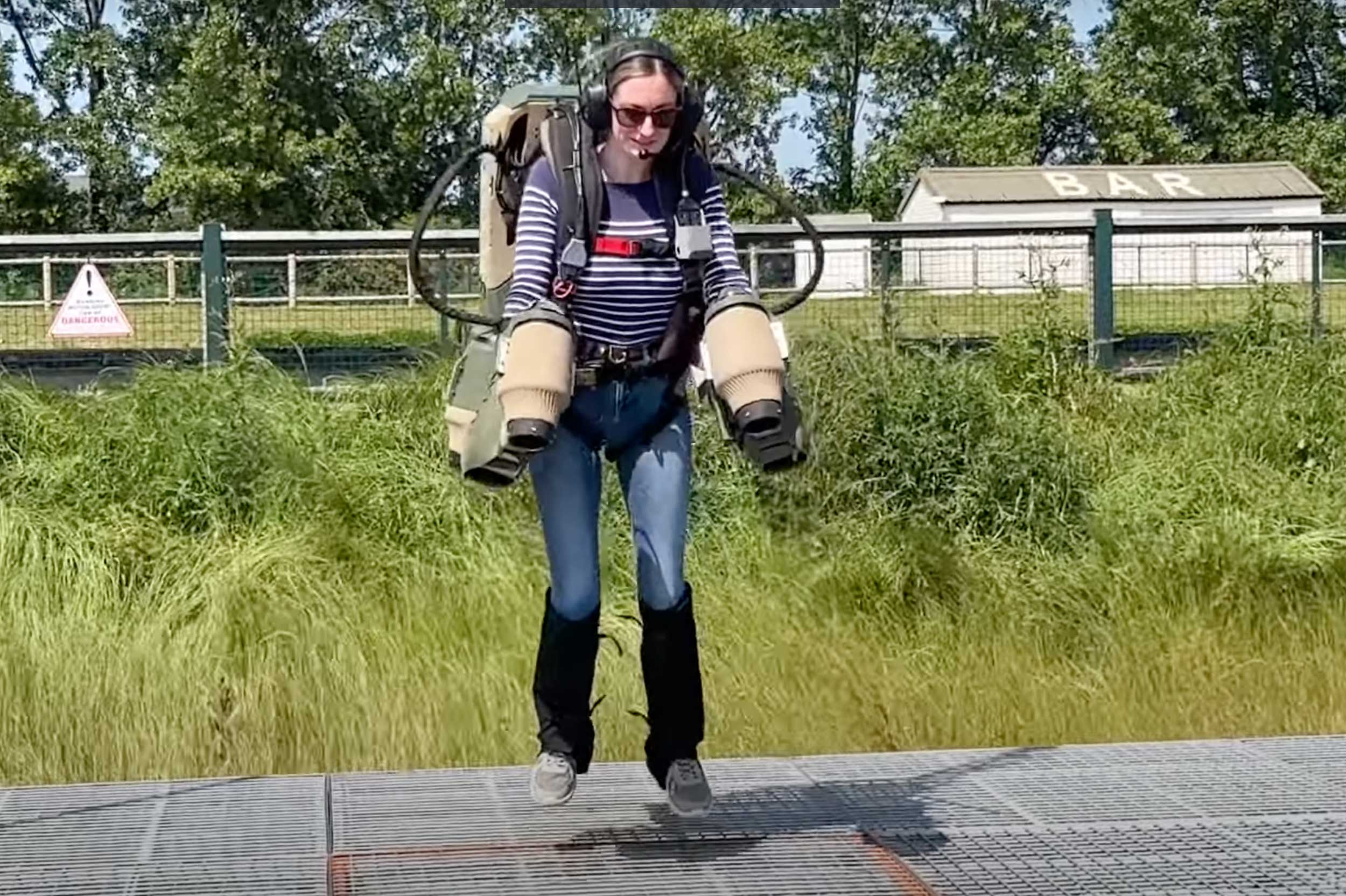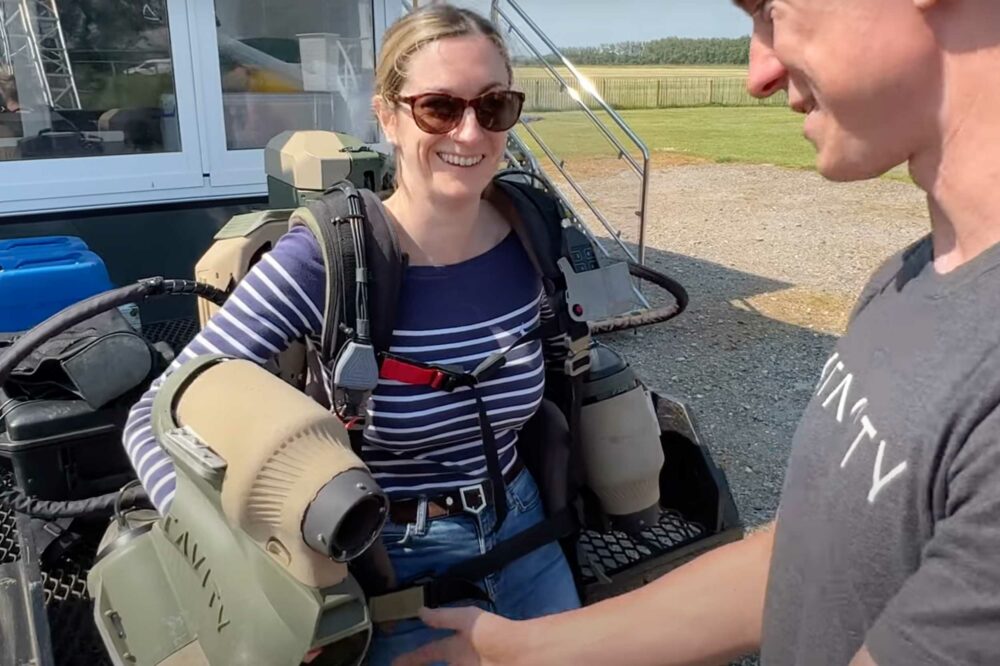Moment of truth
I’m feeling a tad nervous as I walk up the steps onto the training rig for the first time. My instructor for this session is Issa Kalfon, who’s also a GBR gymnast, with whom I’m able to talk with the aid of a headset. I’m clipped onto the bungee cord dangling above me and I’m ready to go.
To start the engines, it’s a quick tap of the throttle and power buttons simultaneously. Once they’re started, Issa then directs me to engage the throttle, and it’s an exciting moment as the engines spool up. We’re in business!
The force of the thrust takes me by surprise, unbalancing me a little at first. This isn’t full power by any means – we’ll work that up gradually while I get used to it. I need to adopt a slightly hunched over posture and Issa reminds me to keep my arms straight as I try leaning into the thrust. Even at this power setting, it’s a strange sensation.
I then practise walking forwards and backwards and from side to side, getting the hang of where my arms need to be to direct the thrust for each direction, raising one arm slightly and moving the other back to turn one way and then the other. While I’m doing this, there’s a large fan on the edge of the rig blowing cool air my way – definitely appreciated on a scorching day surrounded by hot jet thrust!
It’s awesome yet tiring, with the noise, the weight, the fumes, the heat, but it’s inherently not an activity you can do for long, so rests are built in. That’s because I’m carrying 10 litres of fuel, and the jet suit has a fuel burn of 4.5 litres a minute (!). It’s possible to carry up to 20 litres, but in training there’s half that, as it’s already very heavy. After three minutes or so of flight time, there’s no choice but to stop and refuel.
After lunch in the aerodrome’s fantastic cafe, it’s back to the training rig, and Paul’s my instructor for this session. I start by refreshing what I learned this morning, and Paul talks me through vectoring: arms down for take-off, arms out for landing. I’ve still not left the ground.
Paul ups the power a little and directs me to try small vertical jumps to start getting used to the feeling of being light on my feet. Frustratingly, I somehow keep ending up spinning around – I must be making tiny movements with my arms that upset the stability of the thrust. Each time, I arrest the rotation by releasing the throttle and the engines power down.
My arms are getting tired with the effort of holding up four engines with straight arms in front of me, and I’m beginning to wonder whether I’ll ever successfully get my feet off the ground with anything more than the bungee. But all of a sudden, something clicks.
Paul’s told me to look straight ahead (just like when you’re taking off and landing in a helicopter), and that seems to do the trick. It’s incredibly surreal as I feel myself rise up off the ground and, for a few moments, instinctively keep the thrust in balance – it’s a bit like my first successful helicopter hover. A huge grin spreads across my face. I’m flying!
And then I start overthinking it. Feeling myself rotating to the left again, I release the throttle, lightly touching down with the assistance of the bungee cord.
To be sure it wasn’t a fluke, I have one last go, and again achieve a stable hover – a little higher off the ground this time as my confidence grows. I manage another few moments before I start turning again, coming back down with little grace but filled with an enormous sense of satisfaction and excitement.
After this tantalising taster, I can see why Issa’s response to my question about what it’s like to fly a jet suit had been: “I can’t even describe – just total freedom.” I only wish I had a few more days of training ahead of me so I could experience more of what this unique invention has to offer.
There’s one final surprise as I unstrap the suit for the last time. Richard presents me with a bronze token to mark my first hover in a jet suit. There are silver and gold ones for achieving more advanced milestones, but not many people are lucky enough to have those. Paul shows me how it can be used like a spinning top, and I assure them that I’ll treasure it forever.
The future of flying?
Seeing someone flying around in a jet suit is about as futuristic and ‘sci fi’ as it gets, and the experience even of hovering one is, well, the coolest thing ever. But will they constitute a plausible mode of personal transport in the years to come?
They aren’t, of course, a new idea. In the 1960s, they were touted as the next big thing in personal transportation, and it was even suggested that housewives would eventually use them for going shopping. A ‘Jump Jet’ can be seen being demonstrated at Brands Hatch racing circuit in this 1966 Pathé film reel, and you might also remember Sean Connery using one to make a hasty exit the previous year in Thunderball (1965), only the second James Bond film ever made.
According to one of the Thunderball production designers, the pack we see in the film was built by Bell-Textron and could fly for just 20 seconds before running out of fuel. Seemingly undeterred, a 1969 BBC report mentioned Bell’s somewhat optimistic intention to make “a two-man version as well, with a seat for the passenger, who could be a general directing a battle, or you and I going to work.”
Back then, jet packs never really ‘took off’, as it were. At 3.5 to 5 minutes’ flight time, Richard’s creation fares somewhat better than its 1960s ancestors, although it’s still some way off being able to convey someone to and from work or the shops. Weight is an issue, too, and though they’ve been able to train a 150kg customer thanks to the rig, the suit really needs its pilot to weigh 85kg or less for proper use. It would also set you back around £380,000 if you wanted to own and learn to fly one properly – and it would have to stay with Gravity for safekeeping.
It does, however, hold the record for the fastest flight in a body-controlled jet suit – an incredible 85mph – and it can fly in all weathers, day and night. It’s only when the wind starts gusting at 35mph or more that handling it gets tricky. The engines (which require overhaul every 20 hours) essentially act as one moving part, achieving excellent stability once up to speed.
While an engine failure would result in instability, the pilot is in complete control of ground speed and stays near the ground anyway, so it wouldn’t be the disaster you might think. That said, it still looks dramatic, as poor Issa was to find a few weeks later when he suffered an engine failure at the opening of the Austrian F1 Grand Prix (luckily he was fine!).
Richard has demonstrated his extraordinary jet suit in 41 different countries to date, drawing much interest from the military and from search and rescue organisations. Just one example is the Great North Air Ambulance, who reportedly trained up their operational director on the jet suit, hoping eventually to use it to enable paramedics to reach casualties quickly in the challenging terrain of the Lake District.
And Richard’s plans don’t end there. He’s currently developing the Gravity Race Series, a Red Bull Air Race-type event that will bring the jet suit and its possibilities in front of a much wider audience. He’s also opening another training location near Los Angeles, California, enabling more people to experience the thrill of jet suit flying. With packages starting at £2,200 + VAT, it’s not cheap – but can one really put a price on the kudos of doing something this cool?
On which note, a quote from Richard on the Gravity website reads: “To feel your feet lift off the ground, that ultimate freedom of true flight. This will be a day you remember for the rest of your life.”
He was right.
Book a jet suit experience flight via the Gravity Flight Club








